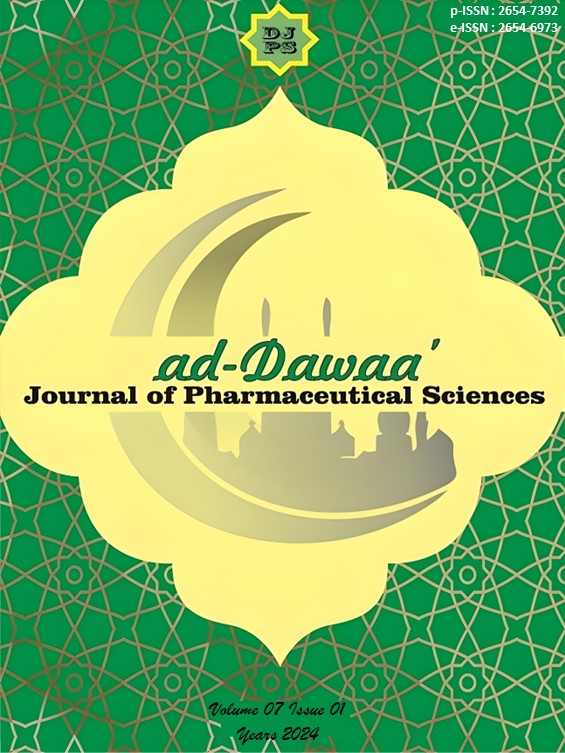Comparative Analysis of the Autodock 4.2 and Autodock Vina Methods in Predicting Thiazolidinedione Interactions with PPARG Receptor
Abstract
Introduction: Molecular docking simulation is an in silico method that plays a role in drug discovery and analyzing drug interactions with receptors. The method using Autodock 4.2 and Autodock Vina is widely used in molecular docking simulations, especially for analyzing interactions that occur between ligands and receptors. Aims: This study was aims to compare the Autodock 4.2 and Autodock Vina methods in simulating the docking of thiazolidinedione against PPARG in terms of bond energy and type of interaction parameters. Methods: The method used in this research was molecular docking simulation using Autodock 4.2 and Autodock Vina. The two methods compared the interaction results and binding affinity scores in the thiazolidinedione group against PPARG. Result: The results of this study show that the interactions using the Autodock 4.2 and Autodock Vina methods have similar amino acids that are bound and the same active site. The binding affinity score also shows that the best are troglitazone, pioglitazone, native ligand and rosiglitazone. Conclusion: Based on the results of this study, it shows that molecular docking simulations using the Autodock 4.2 and Autodock Vina methods thiazolidinedione with PPARG have similar docking score patterns and almost the same types of interactions.
Downloads
References
Garrett M. Morris. (2010). AutoDock Version 4.2 - User Guide. Guide, 1–49.
Irudayaraj, S. S., Stalin, A., Sunil, C., Duraipandiyan, V., Al-Dhabi, N. A., & Ignacimuthu, S. (2016). Antioxidant, antilipidemic and antidiabetic effects of ficusin with their effects on GLUT4 translocation and PPARγ expression in type 2 diabetic rats. Chemico-Biological Interactions, 256, 85–93. doi:10.1016/j.cbi.2016.06.023
Lateef, T., Naeem, S., & Qureshi, S. A. (2020). In-silico studies of HMG-Co A reductase inhibitors present in fruits of Withania coagulans Dunal (Solanaceae). Tropical Journal of Pharmaceutical Research, 19(2), 305–312. doi:10.4314/tjpr.v19i2.13
Mazumder, M., Ponnan, P., Das, U., Gourinath, S., Khan, H. A., Yang, J., & Sakharkar, M. K. (2017). Investigations on Binding Pattern of Kinase Inhibitors with PPARγ: Molecular Docking, Molecular Dynamic Simulations, and Free Energy Calculation Studies. PPAR Research, 2017, 6397836. doi:10.1155/2017/6397836
Miñarro-Lleonar, M., Ruiz-Carmona, S., Alvarez-Garcia, D., Schmidtke, P., & Barril, X. (2022). Development of an Automatic Pipeline for Participation in the CELPP Challenge. International Journal of Molecular Sciences, 23(9). doi:10.3390/ijms23094756
Nickavar, B. (2022). Effect of organosulfur compounds from different garlic preparations on hyperlipidemia: An in-silico approach. Biointerface Research in Applied Chemistry, 12(3), 4048–4061. doi:10.33263/BRIAC123.40484061
Rashid, H. U., Ahmad, N., Abdalla, M., Khan, K., Martines, M. A. U., & Shabana, S. (2022). Molecular docking and dynamic simulations of Cefixime, Etoposide and Nebrodenside A against the pathogenic proteins of SARS-CoV-2. Journal of Molecular Structure, 1247, 131296. doi:10.1016/j.molstruc.2021.131296
Sandeep, G., Nagasree, K. P., Hanisha, M., & Kumar, M. M. K. (2011). AUDocker LE: A GUI for virtual screening with AUTODOCK Vina. BMC Research Notes, 4(Figure 3), 3–6. doi:10.1186/1756-0500-4-445
Sharma, D., Kumar, S., & Narasimhan, B. (2018). Estrogen alpha receptor antagonists for the treatment of breast cancer: A review. Chemistry Central Journal, 12(1), 1–32. doi:10.1186/s13065-018-0472-8
Shivanika, C., Deepak Kumar, S., Ragunathan, V., Tiwari, P., Sumitha, A., & Brindha Devi, P. (2022). Molecular docking, validation, dynamics simulations, and pharmacokinetic prediction of natural compounds against the SARS-CoV-2 main-protease. Journal of Biomolecular Structure and Dynamics, 40(2), 585–611. doi:10.1080/07391102.2020.1815584
Suhandi, C., Fadhilah, E., Silvia, N., Atusholihah, A., Prayoga, R. R., Megantara, S., & Muchtaridi, M. (2021). Molecular Docking Study of Mangosteen (Garcinia mangostana L.) Xanthone-Derived Isolates as Anti Androgen. Indonesian Journal of Cancer Chemoprevention, 12(1), 11. doi:10.14499/indonesianjcanchemoprev12iss1pp11-20
Zloh, M., & Kirton, S. B. (2018). The benefits of in silico modeling to identify possible small-molecule drugs and their off-target interactions. Future Medicinal Chemistry, 10(4), 423–432. doi:10.4155/fmc-2017-0151
Copyright (c) 2024 Muhammad Andre Reynaldi, Aulia Faradilla, Rafika Sari, Hafrizal Riza, Robby Najini

This work is licensed under a Creative Commons Attribution-ShareAlike 4.0 International License.
Once an article was published in the journal, the author(s) are:
- granted to the journal right licensed under Creative Commons License Attribution that allows others to share the work with an acknowledgement of the work's authorship.
- permitted to publish their work online in third parties as it can lead to wider dissemination of the work.
- continue to be the copyright owner and allow the journal to publish the article with the CC BY-SA license
- receiving a DOI (Digital Object Identifier) of the work.


1.png)